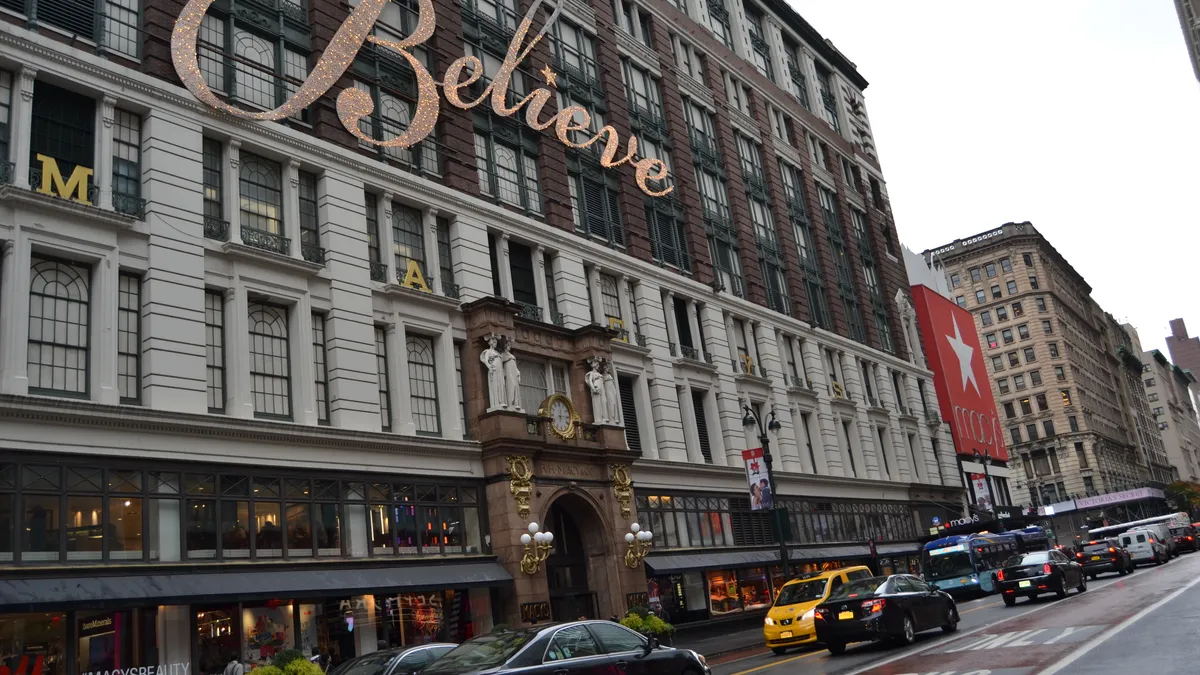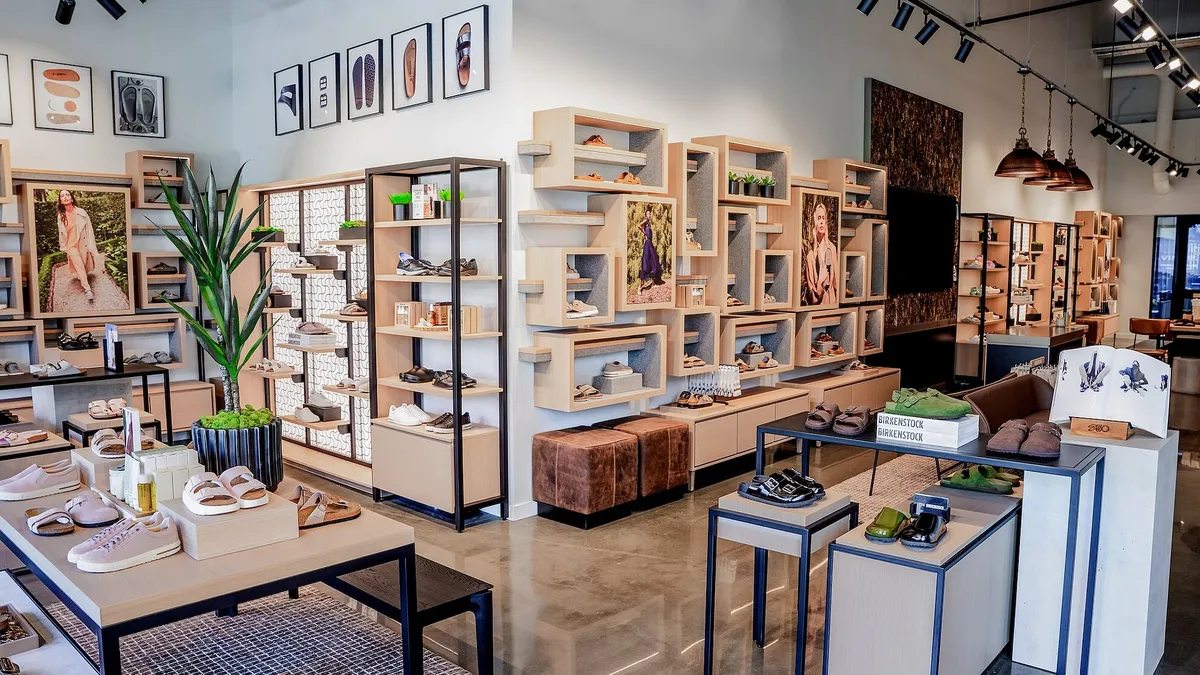New York is always teeming with new retail concepts, especially a few select areas (Hello SoHo). During the holiday season, it's easy to tell with many retailers opening their newest locations in time to get a lift from the countless holiday shoppers looking to leave with lighter wallets.
The range of retailers that set up shop in the Big Apple is huge — from Wild Ones, a pop-up featuring the ten essentials every dog owner needs, to Brooklinen, a direct-to-consumer sheets retailer trying to sell luxury sheets at prices the average Joe can afford.
Here's what a few recent additions tell us about some of the larger trends playing out in retail.
Glossier and the still-blooming beauty category
The beauty startup opened up its first flagship location Nov. 8, on the same real estate that its showroom was previously occupying. The showroom was already turning heads, with many pointing to its touch-and-feel vibe, hands-on customer service and showroom feel as defining features of the concept. That's saying something, considering Glossier operates in an already experience-heavy space, led by the likes of Sephora and Ulta.
The flagship pushes that even further, with an additional focus on being Instagrammable — the location is littered with selfie-worthy stops (and the customers do stop) and not a single item out of place. Even the store associates are placed perfectly around the store, one at roughly every touchpoint, in matching pink jumpsuits.
More broadly, though, Glossier's first flagship speaks to the success of the beauty category as a whole — and it's not the only retailer in the category making changes to stores right before the holidays hit. Plenty of department stores and drugstores have been upgrading their beauty offerings in the lead up to the holidays, bringing in more technology and brand-agnostic store associates, and pushing out a more archaic way of shopping in the process.
Away and the rising direct-to-consumer model
While luggage brand Away has had a presence in NoHo for over a year now (longer than most others on this list), it's worth taking a look at the flagship anyway, if only for what it says about the rest of retail. Away's flagship is similar to many other showroom-style locations. There's a lot of open space, a clean and organized aesthetic and, of course, several different sizes of several different pieces of luggage (always, it seems, ordered by descending height).
The startup isn't just trying to sell luggage, though, it's trying to sell travel. The founders will tell you that themselves, but so will the store for those who look at all the contents. In addition to carry-ons and larger suitcases, Away is smart about throwing in complimentary travel products, like headphones, eye masks and select travel books.
Aside from being a successful luggage store, the Away flagship is also evidence of a growing trend — that of previously online-only retailers moving more and more into physical locations (though carefully trying to avoid the over-expansion that led to many department stores shuttering stores in recent years). Among those ranks are Allbirds, Casper, Glossier and of course Warby Parker, often considered the original "digitally native gone brick-and-mortar" retailer. That trend is likely to continue, according to a study by JLL, which notes that digitally native retailers will open a combined 850 stores within the next five years.
New York Magazine's 'I Found it at the Strategist' and experimental retail
As with many of the others on this list, The Strategist pop-up, which opened Nov. 8 and will stay up through Dec. 30, is nestled among all of the other up-and-coming concepts in SoHo and features a shopping experience a little more outside the box than most consumers are used to. The store offers a range of products, with short descriptions next to each of them.
Based on editors' best product recommendations, the store reads much like a magazine itself. There's a section called "This Thing's Incredible," which features — among other things — a drill-shaped brush to clean your bathroom with, and later on a rack with a bathrobe on it, titled "The Best Bathrobe." Along with a lot of haircare products sitting at a station displayed like a hairdresser's shop, the pop-up also features a rack of T-shirts from The Cut with a sign noting, "You Can Now Wear Headlines Like This One on a Cut T-shirt."
Aside from being an interesting experiment in and of itself, The Strategist pop-up also draws attention to a growing trend in the industry, of retailers using temporary stores to either test out physical retail or push the boundaries of a typical brick-and-mortar experience. While pop-ups are popular at all times of the year — Brandless has used them more than once in the past, in both Los Angeles and New York — they've been especially numerous in the lead up to the holiday season, with Wayfair, Amazon and Macy's all getting in on holiday-specific pop-ups, as well as odder combinations, like the Good Housekeeping and Amazon joint pop-up in the Mall of America.
The Market @ Macy's and the road to department store innovation
The Macy's flagship in Herald Square is remarkable for many reasons, not least of all the sheer amount of square footage it takes up. This holiday season, though, the store has more to offer shoppers than a visit to Santa Claus and the annual reminder to believe. A new store-within-a-store concept, The Market @ Macy's, debuted this year for the holiday season, through a partnership with Facebook.
The installation was featured prominently in the department store, right inside the entrance at 34th and 7th, and displayed a wide variety of products for the wandering shopper. There were products from the likes of Love Your Melon and Two Blind Brothers, two charitable retail organizations, nearby an interactive Ferrari station, a vegetable spiralizer and a few rather innocuous-looking makeup brands.
The Market @ Macy's was a stone's throw away from another big investment of Macy's this year, retail concept b8ta. Both areas seemed to operate on a similar model — an open-floor space with products laid out to test, though in the latter's case they leaned toward more technology-based products, like a robot vacuum, a smart mirror and a digital canvas. Both are evidence that Macy's — and other department stores with it — are innovating on what the department store model is and what it should be.
Brideside and the threat of category disruption
Brideside, a store dedicated to selling bridesmaids' dresses instead of the bride's, opened up a flagship in the Flatiron district Tuesday (its third physical location), with a model that leans toward personalized service and a friendly and light atmosphere, a departure from the often stiff and formal process of shopping for wedding gowns.
The small store has an intimate feel, with brightly-colored couches spread down the length of the floor and dresses lined up along the sides, organized by color. In addition to cozy places for the bridal party to sit down and talk, and dressing rooms, the small flagship also dedicates a few displays to related categories, including good party favors, some travel-related accessories (ostensibly for the honeymoon or a bachelorette trip) and even a small tie display.
The specialty retailer is, so far, succeeding in an industry that has seen a lot of shakeup lately. Alfred Angelo filed for bankruptcy last year, David's Bridal is on the verge of Chapter 11 itself (and by the time you read this, may have already filed), and both Vow to be Chic and Weddington Way have been shut down within the year. Into that void, wedding registry business Zola continues to thrive and, based on this recent opening, Brideside isn't doing poorly either. It's a story we've told before — most recently, with the rude awakening Casper has given to the mattress industry — and a reminder that sleepy sectors ripe for innovation don't always stay sleepy for long.























